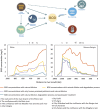Organic pollution of rivers: Combined threats of urbanization, livestock farming and global climate change
- PMID: 28230079
- PMCID: PMC5322379
- DOI: 10.1038/srep43289
Organic pollution of rivers: Combined threats of urbanization, livestock farming and global climate change
Abstract
Organic pollution of rivers by wastewater discharge from human activities negatively impacts people and ecosystems. Without treatment, pollution control relies on a combination of natural degradation and dilution by natural runoff to reduce downstream effects. We quantify here for the first time the global sanitation crisis through its impact on organic river pollution from the threats of (1) increasing wastewater discharge due to urbanization and intensification of livestock farming, and (2) reductions in river dilution capacity due to climate change and water extractions. Using in-stream Biochemical Oxygen Demand (BOD) as an overall indicator of organic river pollution, we calculate historical (2000) and future (2050) BOD concentrations in global river networks. Despite significant self-cleaning capacities of rivers, the number of people affected by organic pollution (BOD >5 mg/l) is projected to increase from 1.1 billion in 2000 to 2.5 billion in 2050. With developing countries disproportionately affected, our results point to a growing need for affordable wastewater solutions.
Conflict of interest statement
The authors declare no competing financial interests.
Figures





References
-
- UNICEF & WHO. Progress on Sanitation and Drinking Water: 2015 Update and MDG Assessment. (UNICEF, 2015).
-
- Vörösmarty C. J. et al. Global threats to human water security and river biodiversity. Nature 467, 555–561 (2010). - PubMed
MeSH terms
Substances
LinkOut - more resources
Full Text Sources
Other Literature Sources
Medical

